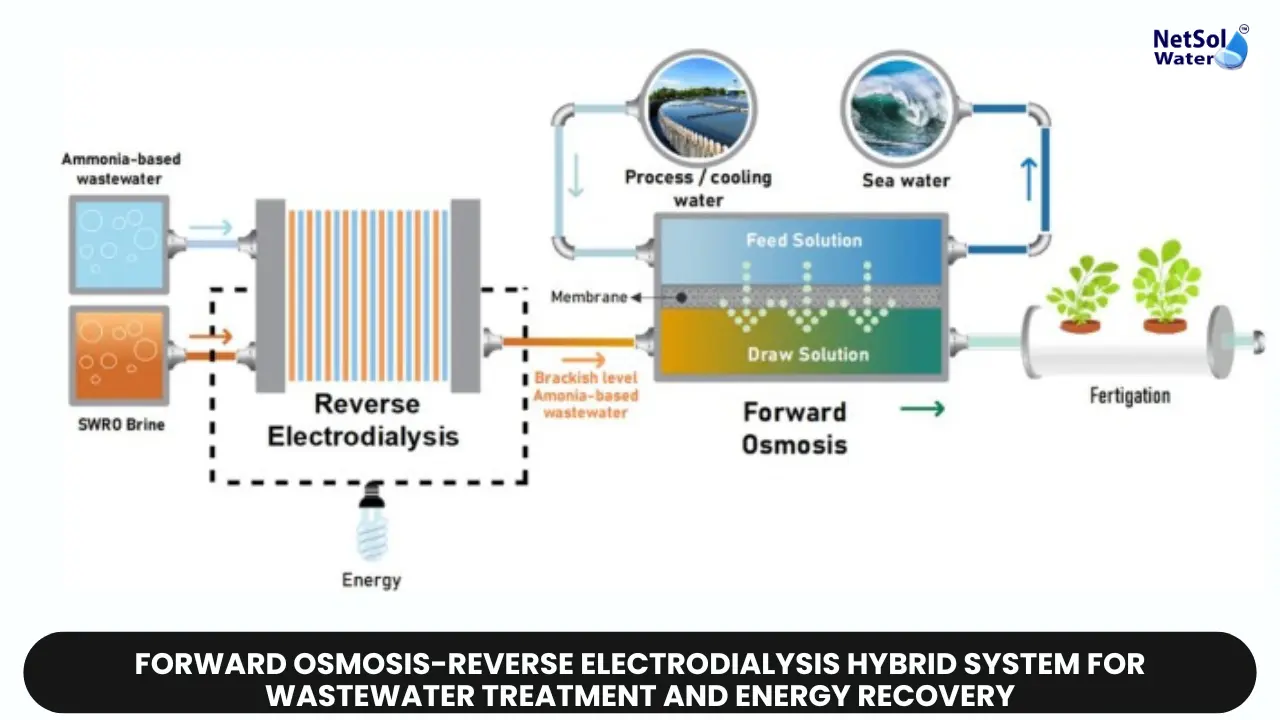Forward Osmosis-Reverse Electrodialysis Hybrid System for Wastewater Treatment and Energy Recovery
Treating wastewater is important for safeguarding public health and the environment, but it requires significant energy inputs. Traditional methods like activated sludge processes and membrane bioreactors consume substantial energy for aeration, pumping, and membrane filtration. Researchers have been exploring innovative approaches that can treat wastewater effectively while recovering valuable resources like clean water and energy. One promising technology is the forward osmosis-reverse electrodialysis (FO-RED) hybrid system, combining forward osmosis for wastewater treatment and reverse electrodialysis for energy recovery.
Forward Osmosis: Treating Wastewater through Natural Osmosis
Forward osmosis (FO) is a membrane-based process that utilizes the natural phenomenon of osmosis to separate water from contaminants in wastewater. It involves a semi-permeable membrane separating a feed solution (wastewater) from a draw solution (highly concentrated solution). Due to osmotic pressure difference, water molecules from the feed pass through the membrane, diluting the draw solution.
After forward osmosis, the diluted draw solution is separated from the concentrated wastewater stream. Techniques like membrane distillation or reverse osmosis can regenerate the draw solution, recovering clean water and regenerating the concentrated solution.
Forward osmosis offers advantages like lower energy use, reduced membrane fouling, and ability to treat challenging wastewater with high salinity or organic content.
Reverse Electrodialysis: Generating Electricity from Salinity Gradients
Reverse electrodialysis (RED) generates electrical energy from controlled mixing of solutions with different salinity levels, like seawater and freshwater. It exploits the chemical potential difference between solutions to create an electrical potential harnessed to produce electricity.
Key RED components include ion exchange membranes (allowing selective ion passage), electrode compartments (containing electrodes and conductive solution), and feed compartments (alternately filled with high and low salinity solutions).
As solutions flow through feed compartments, ions migrate through membranes, creating an electrical potential difference between electrode compartments – which can generate electrical current to power external loads.
The FO-RED Hybrid System: Combining Wastewater Treatment and Energy Recovery
The FO-RED hybrid system integrates forward osmosis' wastewater treatment capabilities with reverse electrodialysis' energy recovery potential. The diluted draw solution from forward osmosis serves as the low-salinity solution in reverse electrodialysis, while a high-salinity solution (e.g., seawater or brine) is the high-salinity solution.
Key steps include:
1. Wastewater treatment via forward osmosis, producing concentrated wastewater and diluted draw solution.
2. Draw solution regeneration using reverse electrodialysis, generating electrical energy while recovering clean water.
3. Energy recovery, offsetting wastewater treatment plant's energy requirements.
Advantages include energy recovery (offsetting treatment costs), resource recovery (clean water), low membrane fouling rates, and versatility in treating various wastewater streams.
Advancing Sustainable Water and Energy Management
While still in research and development, the FO-RED hybrid system offers a unique solution addressing wastewater treatment and energy recovery challenges. By combining forward osmosis and reverse electrodialysis, it treats wastewater effectively while generating energy from salinity gradients.
Pilot studies and lab experiments demonstrate promising results. As the technology matures and scales up, it could find applications in municipal plants, industrial facilities, and off-grid locations prioritizing energy recovery and water reuse.
As regulations tighten and sustainable practices become imperative, innovative systems like FO-RED will play a crucial role. Recovering resources from wastewater and generating energy contributes to a more sustainable, circular approach to water and energy management.
Conclusion
The forward osmosis-reverse electrodialysis hybrid system represents an innovative approach to sustainable wastewater treatment and energy recovery. By harnessing natural osmosis for wastewater treatment and salinity gradients for power generation, it offers a unique solution addressing two critical challenges.
While still an emerging technology, the FO-RED system shows promise in reducing energy consumption, recovering valuable resources, and promoting a more circular economy for water and energy management. As research progresses and scale-up efforts continue, this hybrid system could revolutionize how we approach wastewater treatment and resource recovery, paving the way for a more sustainable future.
Do you need an advice or assistance on selecting the best water and waste water treatment unit? We have solutions for all your problems!
Let us now your problem, our experts will make sure that it goes away.
For an assistance or related query,
Call on +91-965-060-8473
Or write us at enquiry@netsolwater.com



